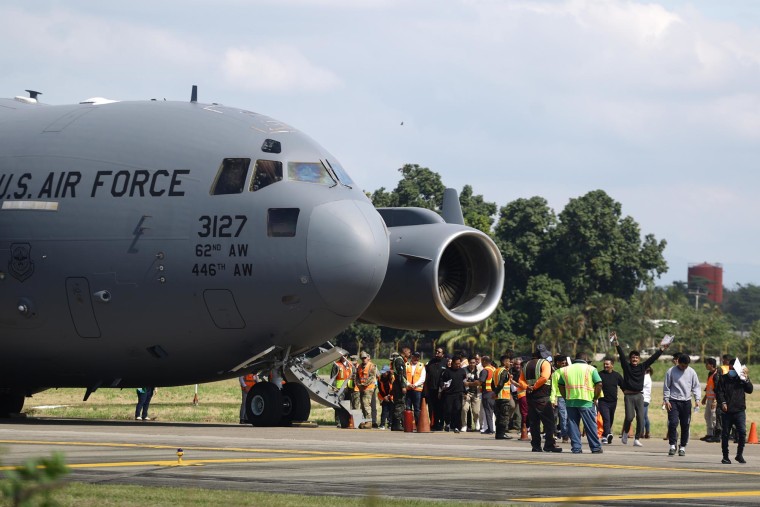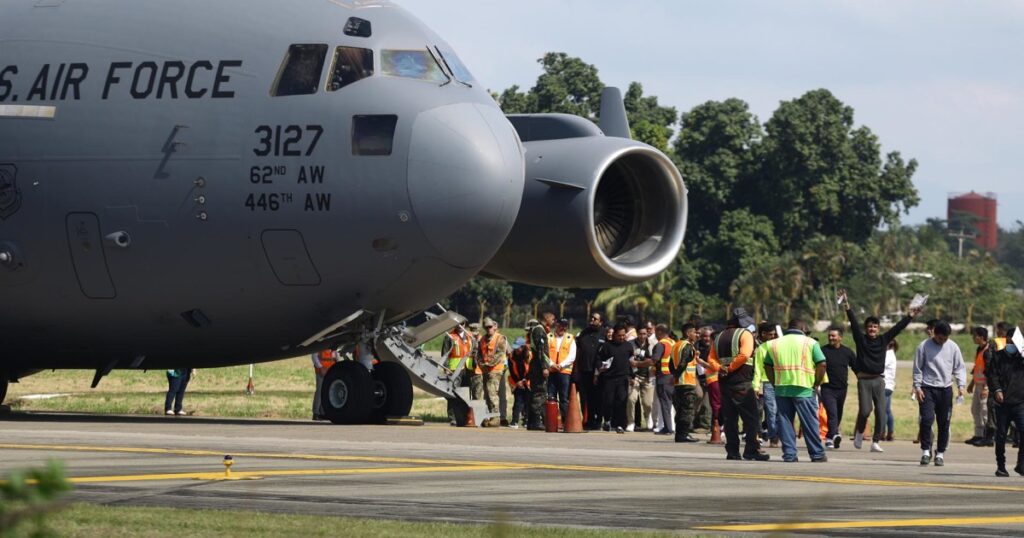Four days after President Donald Trump returned to office, White House press secretary Karoline Leavitt made an announcement: “Deportation flights have begun. President Trump is sending a strong and clear message to the entire world: If you illegally enter the United States of America, you will face severe consequences.”
Trump began using U.S. military planes to reinforce his deportation operation, although Immigration and Customs Enforcement (ICE) has been deporting immigrants on private airlines since 2010.
But a month and a half after the White House announcement, the pace of deportation flights is a bit slower than those of his predecessor, former President Joe Biden. Also, the number of immigrants expelled through flights has decreased and the government has stopped using military aircraft, which according to immigration experts was more expensive and inefficient.
The findings are based on a Noticias Telemundo analysis of data on deportation flights and interviews with Central American government officials and experts who have analyzed these immigration operations in recent years.
Para leer en español haga click aquí
In Latin American countries such as Guatemala, Honduras and Ecuador — which receive the most deportation flights — authorities say they have not seen major changes in operations compared to previous U.S. administrations. They even predict that, if the current trend of the Trump administration continues, 2025 would end with fewer flights and fewer deportees.

The decline in flights and deportees is partly due to a drop in border crossings since Trump took office, which has left immigration authorities with fewer people eligible for “expedited removal,” which is used to expel those caught at the border or in an area within 100 miles of the border, and within 14 days of arrival to the country.
For the analysis, Noticias Telemundo developed a database of Trump administration deportation flights based on news reports, official government information, websites that record aeronautical information and data collected by Thomas Cartwright of the group Witness at the Border, which has tracked U.S. deportation flights since 2020.
Data shows that in February, 128 flights with deportees took off, including 19 military flights. That figure is lower than Immigration and Customs Enforcement’s 137 deportation flights in February 2024.
The main destinations of February’s deportation flights were Honduras and Guatemala, countries that for years have received weekly flights with deportees.
Consulted by Noticias Telemundo, the directors of both nations’ migration institutes said that so far the only difference in the operation compared to previous administrations was the use of military aircraft. Otherwise, the pace of deportation flights remains about the same, they said.
“There is no radical change other than the issue of deportations made by military flights,” said Wilson Paz, director of Honduras’ National Institute of Migration. He agreed with Honduran Foreign Minister Enrique Reyna, who in mid-February told local media they weren’t seeing mass deportations from the U.S.
Guatemala had a similar assessment. “Compared to the previous year, it’s a lower number of returnees (…) on the issue of deportation we cannot talk about radical changes,” Danilo Rivera, director general of the Guatemalan Institute of Migration, said.
On average, Guatemala received 5,140 monthly deportees by air during 2024. In February of last year, the United States expelled 6,972 Guatemalans on 58 flights. This year, during the same month, the Trump administration deported a little over 2,000 Guatemalans on 24 flights, according to Guatemalan government data.
Ecuador received 13 deportation flights between Jan. 20 and Feb. 28. Government officials estimate that, at that rate, they could end the year with fewer than 100 flights, a notable difference compared to the 150 flights the South American country received last year, Ecuadorian Deputy Foreign Minister Alejandro Davalos said in a public discussion on social network X on Feb. 25.
Davalos said about 30,000 undocumented Ecuadorians in the U.S. have deportation orders, but he was skeptical that the Trump administration could expel them soon. “Those deportation orders have not been executed and will not be executed in the immediate future, they were not in the past and they will certainly not be in the coming months. We are not going to have a massive flow of deported Ecuadorians,” the deputy foreign minister said.
On March 9, Ecuador’s President Daniel Noboa said that the country won’t receive immigrants deported from the U.S. who are not Ecuadorian, as Panama and Costa Rica have done in recent weeks.
Authorities in Honduras and Guatemala say that the vast majority of the people they’re receiving don’t have serious criminal records in the U.S. beyond having entered the country without permission or committing traffic violations.
NBC News reported this week that of the people deported by the Trump administration in February, about half had no criminal convictions or pending criminal charges.
“We cannot continue to criminalize or treat them as criminals when we are observing that almost all of them are working people, they are people who have dignity,” Rivera said.
“Maybe less than 1% have any criminal history,” Wilson Paz said. Despite that, all deported Honduran adults fly handcuffed on planes hired by ICE, the official explained.
The Honduran government has asked the U.S. to release the restrained deportees once the planes enter Honduran airspace, Paz said. “(We request) in a non-negotiable way, respect for human rights, the dignity of Honduran migrants to return to their territory without handcuffs, without shackles, because here they are free,” he said.
The U.S. Department of Homeland Security (DHS) did not respond to questions about the decrease in deportation flights between February 2024 and February 2025, and whether they plan to increase the number of flights.
The decrease in deportation flights took place as President Trump pressured countries such as Panama, Honduras and Costa Rica to accept planes with deportees of other nationalities and the administration used military aircraft to carry out the deportations.
In early March, the Defense Department suspended the use of C-17 jets to transport undocumented people to the U.S. base at Guantanamo Bay and other countries.
In total, the Trump administration conducted 29 military flights to seven countries, mostly Guatemala. But those flights ended up being more expensive and less efficient than the commercial flights usually contracted by ICE to expel migrants.
An hourlong flight of a Boeing C-17 jet, designed to carry cargo and soldiers, costs about $28,500, according to the military’s Air Mobility Command. By contrast, the average one-hour flight cost of a regular charter plane hired by ICE is $8,577 and the cost of “special high-risk” charter flights is $6,929 to $26,795 per hour, according to ICE.
Military flights to Latin America have also been more expensive because aircraft have taken longer routes, avoiding Mexico’s airspace, which has not allowed military planes carrying deportees to land. Mexico continues to receive ICE charter flights; between January and Feb. 11, they transported almost 2,000 Mexicans from Texas and Arizona, according to data provided by the Mexican government.
The military flights carried out by the Trump administration since Jan. 24 carried an average of 68 passengers per trip, while regular ICE flights on private airline planes carried an average of 105 passengers, according to data analyzed by Noticias Telemundo.
On Jan. 31, the military flight that transported 17 migrants to Honduras and 34 to Peru lasted about 19 hours round trip, according to FlightRadar data. Deporting those 51 people likely cost U.S. taxpayers more than half a million dollars, about $10,000 for each deportee.
The decrease in deportation flights took place despite the fact that Colombia has been sending planes from its Air Force to pick up deported Colombians following a diplomatic crisis between Trump and Colombian President Gustavo Petro, who refused to allow military flights to land in the country. Petro decided to use the Colombian planes after Trump threatened to impose tariffs on all Colombian products imported into the U.S. as well as implement a travel ban and immediately revoke the visas of Colombian government officials.
In total, the Colombian Air Force conducted 10 repatriation flights between late January and February. In addition, Venezuela sent two flights to Texas to repatriate nearly 200 Venezuelans on Feb. 10. despite the fact that President Nicolás Maduro had refused to receive flights with deportees from the U.S. the year before.
Venezuela also sent another Conviasa Airline plane to Honduras to pick up 177 Venezuelans expelled from the naval base at Guantanamo Bay, Cuba, on Feb. 20.
The Trump administration has released images of immigrants boarding military planes in chains and the administration’s border czar, Tom Homan, said in January that Army aircraft with deportees would take off every day.
Experts said they thought the use of military aircraft was publicity strategy to increase the visibility of Trump’s crackdown on illegal immigration and persuade immigrants to desist from crossing into the U.S. illegally.
“It is neither efficient nor productive (…) but I’m not surprised by the use of military aircraft,” Ariel Ruiz Soto, a senior analyst at the Washington, D.C.-based Migration Policy Institute, told Noticias Telemundo.
“It’s a tactic by President Trump to reduce the incentives to arrive at the border irregularly and also increase a certain sense of fear in the undocumented immigrant community that they could be subject to deportation, even though most of them would not,” Ruiz explained.
Fewer deportations — and fewer crossings
The data seems to indicate that the focus on the military flights, along with the deployment of troops to the southern border and the increase in arrests of undocumented immigrants and images of immigrants in chains are working in stopping the flow of people trying to cross into the U.S. without permission. According to the Department of Homeland Security, the government recorded 8,347 arrests of immigrants crossing illegally from Mexico in February, the lowest number in 15 years.
That abrupt drop is reflected in the decrease in deportation flights. Now, with fewer crossings, there are also fewer people to deport immediately, Ruiz said.
“During the Biden administration, especially in early 2024, most of the people they deported were those who had just crossed the border with Mexico and the United States,” he explained.
“To maintain those kinds of high deportations, President Trump has to rely on arrests in the interior of the country,” Ruiz said. But detaining and expelling undocumented immigrants who have been living in the U.S. for years and who are entitled to a process in overcrowded immigration courts, can take years.
In Central America, the kinds of deportees returning via flights points to a decrease in migration to the U.S. Last year, 8 out of 10 deportees Guatemala received were detained at the U.S. border. Currently, a third of Guatemalans coming back had been living in the U.S. for years, Danilo Rivera said.
“We’re starting to get a little bit more people who had the experience of living, working and going on with their lives in the United States,” he said.
In 2023, an average of 1,500 migrants a day moved through Honduras on their way to the U.S. “Today, we are not even reaching 100 or 150 people who transit through our country,” said Wilson Paz, the country’s director of migration.
“Rather, the migratory dynamic has taken a turn, no longer from south to north, but from north to south, because many of these people are returning to their countries and transiting through Honduras, but in reverse,” the official explained.


